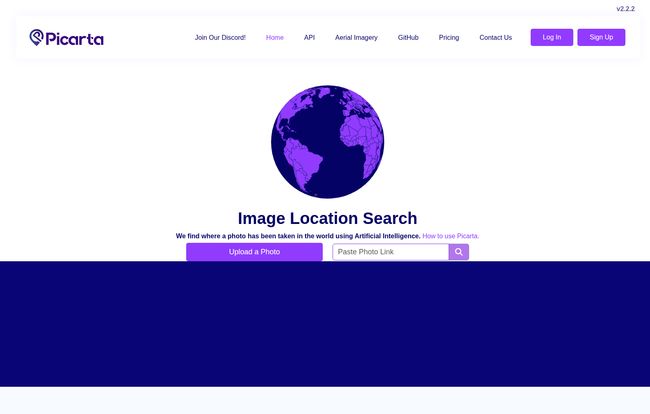You’ve been there. Scrolling through your feed, you see an incredible travel photo. A stunning, secluded beach or a bizarre-looking building in a city you can't quite place. Your first thought: where is that? For years, our best bet was a clunky reverse image search, hoping someone else had posted the same pic with a caption. Or maybe you'd start looking for clues, like a digital Sherlock Holmes. The language on a street sign, the style of architecture, the type of foliage...
It's a fun game, sure. The whole OSINT (Open-Source Intelligence) community is built on this kind of digital sleuthing. Think of the incredible work by groups like Bellingcat, pinpointing locations from just a few frames of a video. But it’s hard work. It takes time. And frankly, sometimes I just want the answer.
Well, the game is changing. AI is stepping in, and tools are emerging that feel like something straight out of a spy movie. One that's been making waves recently is Picarta. I’ve been playing around with it for a while, and I have some thoughts. Lots of them.
So, What on Earth is Picarta?
Let's boil it down. Picarta is an AI-powered platform that tells you where a photo was taken. You give it an image, and its brain—a sophisticated neural network—analyzes it and spits out a predicted GPS location. It’s essentially Shazam, but for places. Instead of listening for a melody, it's looking for digital breadcrumbs: landmarks, building styles, typography on signs, even the position of the sun.
The homepage is deceptively simple. A big purple button that says “Upload a Photo” and a field to paste a link. No fluff. I like that. It gets straight to the point. You upload your mystery pic, and the AI gets to work.

Visit Picarta
I threw a few test images at it. A picture of a side street in Kyoto I took years ago. A random shot of the Golden Gate Bridge from an odd angle. A tricky one of a generic-looking European town square. The results? Surprisingly good. It nailed Kyoto, got the Golden Gate Bridge spot on, and for the European square, it gave me a location in the Czech Republic that was damn close. Not perfect every time, but the accuracy was impressive enough to make me sit up and take notice.
The AI Magic Behind the Curtain
How does it pull this off? It's not just matching your picture to a database of identical ones. Picarta’s AI is more like a seasoned globetrotter who has memorized the subtle details of the entire world. It’s been trained on an astronomical number of geotagged images. It learns that certain types of roof tiles are common in Tuscany, or that a specific style of fire hydrant is unique to New York City. It’s pattern recognition on a planetary scale.
The AI breaks down your image into thousands of tiny data points and compares them against its vast knowledge base. The quality of your photo matters, of course. A blurry, low-res image of a brick wall is a tough ask for any AI. But give it something with a few clues—a bit of skyline, a unique storefront, a distinctive tree—and it has a real fighting chance. It's a powerful approach to geolocalization that goes way beyond what a simple search engine can do.
More Than Just a Pin on a Map
While the main event is obviously the location finder, Picarta has a few other tricks up its sleeve that are worth mentioning.
The Power of EXIF Data
Before you even use the AI, there's a simpler source of information that's often embedded right in the photo file itself: EXIF data. This is metadata your camera or phone automatically saves, including things like the camera model, aperture, shutter speed, and sometimes—if the setting was enabled—the exact GPS coordinates where the photo was taken. Picarta includes an EXIF data viewer, which is a fantastic first step in any investigation. Sometimes the answer is right there, no AI needed.
An API for the Developers
This is where things get really interesting for the tech crowd. Picarta offers an API. This means developers can integrate Picarta’s geolocalization power directly into their own applications. Imagine a travel app that could identify locations from user photos, or a journalism tool that helps verify the source of images in real-time. The potential here is huge, and offering API access shows they're thinking about more than just a consumer-facing website.
Who is This Tool Actually For?
I can see a few groups getting a real kick out of this.
- The OSINT Community & Journalists: This is the obvious one. For professionals who need to verify locations for news stories or investigations, this is a massive time-saver. It won't replace manual verification, but it's an incredible starting point.
- The Casual Sleuth & GeoGuessr Champs: Let's be honest, it's just fun. If you're the kind of person who loves a good mystery or spends hours mastering GeoGuessr, Picarta is like a new superpower.
- Photographers and Creators: Want to find that exact spot where another photographer took an epic shot? Or maybe you forgot where you took a photo from an old hard drive. Problem solved.
- Developers and Businesses: As mentioned, the API opens up a world of possibilities for building location-aware features and products.
Let’s Talk Money: Picarta's Pricing Tiers
Alright, the big question. What does this magic cost? The pricing structure is actually quite flexible, which I appreciate. They seem to understand that a journalist has different needs than someone just trying it out for fun. On their pricing page, there seems to be a slight discrepancy between the text list and the image for the free plan (one says 3 searches, the other 2). I went with the more detailed card info.
| Plan | Price | Best For | Details |
|---|---|---|---|
| Free | Free | Trying it out | 2 Searches / day, 100 API calls / month |
| Wallet | $12.99 | Hobbyists & personal projects | 100 searches, 200 API calls (One-time payment) |
| Monthly | $59.99/mo | Developers & power users | 1000 searches/mo, then $0.045/image |
| Enterprise | Contact them | Corporations & large projects | Offline models, custom portals, dedicated instances |
The one-time payment Wallet option is brilliant. No subscription anxiety, just a block of searches you can use whenever. For a casual user like me, that’s the sweet spot. The free plan is fine for a quick look, but you'll hit that daily limit fast if you're really curious.
The Good, The Bad, and The AI
No tool is perfect. In my experience, Picarta is incredibly powerful, but it's important to have realistic expectations. The AI is a marvel, but it's not an oracle. Its accuracy is directly tied to the quality and distinctiveness of the image you provide. It might struggle with a generic forest, but it will probably nail a shot of the Eiffel Tower, even from a weird angle.
The free plan's limits feel a little tight, pushing you towards a paid plan pretty quickly if you have more than a passing interest. But then again, running these massive AI models isn't cheap, so I get it. The real win for me is the existence of that one-time payment tier. I wish more SaaS companies would do that.
Frequently Asked Questions
- Is Picarta always 100% accurate?
- No, and no tool like this can be. Its accuracy depends heavily on the image quality, the number of unique identifiers in the photo (buildings, signs, landmarks), and the data it was trained on. It provides a highly educated guess, which is often very close or spot-on, but it's a probability, not a certainty.
- Can Picarta find the location of any photo?
- It will try, but it has limitations. A photo taken inside a generic apartment or a close-up shot with no background context will likely yield no results. It needs visual clues to work with.
- Is using Picarta legal and ethical?
- Using the tool itself is legal. However, the ethics depend on the application. Using it to identify a beautiful public park from a travel blog is fine. Using it to track or stalk an individual by locating their private home from a photo is not. It’s a powerful tool, and with great power comes great responsibility.
- How is this different from Google Reverse Image Search?
- Google looks for visually similar or identical images across the web. If it finds the same photo on a travel blog that names the location, it works. Picarta analyzes the content within the photo itself to predict a location, even if that specific photo has never been online before.
- What is EXIF data again?
- It's metadata stored inside a digital photo file. It can include camera settings, date, time, and sometimes GPS coordinates. Picarta has a tool to view this data, which can sometimes give you the location instantly without even needing the AI.
- Do I need an account to use Picarta?
- You can run a few searches for free without an account to see how it works, but to see full results and access the paid plans, you'll need to sign up. Its a pretty standard model for these kinds of services.
My Final Take: A New Must-Have in the Digital Toolkit?
Picarta is one of those tools that, once you use it, you wonder how you managed without it. It's not magic, but it's the closest thing we have to it for image geolocalization right now. It represents a significant leap in accessible AI for everyday curiosity and professional intelligence gathering.
While it has its limits, the sheer power of its core function, combined with a sensible pricing model (especially that one-time payment option), makes it a standout. Whether you're a journalist on a deadline, an OSINT pro, or just a deeply curious person, Picarta is absolutely worth a try. Just be prepared to lose an afternoon falling down the rabbit hole of “I wonder where that was taken…”



